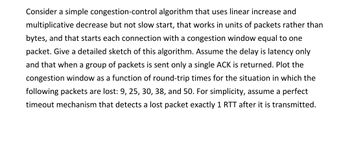
Database System Concepts
7th Edition
ISBN: 9780078022159
Author: Abraham Silberschatz Professor, Henry F. Korth, S. Sudarshan
Publisher: McGraw-Hill Education
expand_more
expand_more
format_list_bulleted
Concept explainers
Question

Transcribed Image Text:Consider a simple congestion-control algorithm that uses linear increase and
multiplicative decrease but not slow start, that works in units of packets rather than
bytes, and that starts each connection with a congestion window equal to one
packet. Give a detailed sketch of this algorithm. Assume the delay is latency only
and that when a group of packets is sent only a single ACK is returned. Plot the
congestion window as a function of round-trip times for the situation in which the
following packets are lost: 9, 25, 30, 38, and 50. For simplicity, assume a perfect
timeout mechanism that detects a lost packet exactly 1 RTT after it is transmitted.
Expert Solution
This question has been solved!
Explore an expertly crafted, step-by-step solution for a thorough understanding of key concepts.
This is a popular solution
Trending nowThis is a popular solution!
Step by stepSolved in 3 steps with 1 images

Knowledge Booster
Learn more about
Need a deep-dive on the concept behind this application? Look no further. Learn more about this topic, computer-science and related others by exploring similar questions and additional content below.Similar questions
- Please give me correct solution.arrow_forwardAll packets are treated equally in Priority Queuing. Select one: O True O Falsearrow_forwardTo ensure the quality of service, especially for multiple applications, regulating the rate at which packets are sent to the network is an important strategy. The leaky bucket is just one of such mechanisms. A flow of packets is said to conform to the leaky bucket specification (r, b), where r is the average rate and b is the burst rate, if the number of packets arriving at the leaky bucket is less than r*t + b in every time interval of t. What is the implication of that? What will happen if the number of packets arriving at the leaky bucket is equal to or greater than r*t + b?arrow_forward
- The program should be in C++. Please use easy logic for a beginner with a proper indentations and commentsarrow_forwardIn TCP Vegas, the calculation of Actual Rate is done by dividing the amount of data transmitted in one RTT interval by the length of the RTT. (a) Show that for any TCP, if the window size remains constant, then the amount of data transmitted in one RTT interval is constant once a full window-full is sent. Assume that the sender transmits each segment instantly upon receiving an ACK, packets are not lost and are delivered in order, segments are all the same size, and the first link along the path is not the slowest. (b) Give a timeline sketch showing that the amount of data per RIT above can be less than Congestion Window.arrow_forwardQuestion 1a and 1b pleasearrow_forward
- In the congestion control method of TCP we are having a connection between nodes A and node B which is called connection X. There is another TCP connection between node C and node D which is called connection Y. The initial threshold window size for connection X is 20 KB and for Y is 16 KB. Both the connections X, Y are working independently and follow the Additive increase multiplicative decrease algorithm (AIMD) for congestion control with a maximum segment size of 2 KB. The first timeout occurs at the fifth transmission in connection X and at the sixth transmission in connection Y. After every third transmission from timeout, you again encounter the timeout in both X and Y. At which transmission the connection Y reaches to the same threshold value of the connection X for the first time.arrow_forwardI need the answer as soon as possiblearrow_forwardIn a two-phase, total-order multicast system, messages are sent in the following sequence from node S to G1 and G2. G1 and G2 are the members of the group. S sends m1 to G1 S sends m1 to G2 S sends m2 to G2 S sends m2 to G1 Use the basic implementation of the Lamport clock. The clock s at each node start at: S: 4, G1: 6, G2: 1. Show the exchange of messages and their acknowledgments in a clock diagram using the basic implementation of Lamport's clock. In which order and at what times are m1 and m2 delivered?arrow_forward
arrow_back_ios
arrow_forward_ios
Recommended textbooks for you
 Database System ConceptsComputer ScienceISBN:9780078022159Author:Abraham Silberschatz Professor, Henry F. Korth, S. SudarshanPublisher:McGraw-Hill Education
Database System ConceptsComputer ScienceISBN:9780078022159Author:Abraham Silberschatz Professor, Henry F. Korth, S. SudarshanPublisher:McGraw-Hill Education Starting Out with Python (4th Edition)Computer ScienceISBN:9780134444321Author:Tony GaddisPublisher:PEARSON
Starting Out with Python (4th Edition)Computer ScienceISBN:9780134444321Author:Tony GaddisPublisher:PEARSON Digital Fundamentals (11th Edition)Computer ScienceISBN:9780132737968Author:Thomas L. FloydPublisher:PEARSON
Digital Fundamentals (11th Edition)Computer ScienceISBN:9780132737968Author:Thomas L. FloydPublisher:PEARSON C How to Program (8th Edition)Computer ScienceISBN:9780133976892Author:Paul J. Deitel, Harvey DeitelPublisher:PEARSON
C How to Program (8th Edition)Computer ScienceISBN:9780133976892Author:Paul J. Deitel, Harvey DeitelPublisher:PEARSON Database Systems: Design, Implementation, & Manag...Computer ScienceISBN:9781337627900Author:Carlos Coronel, Steven MorrisPublisher:Cengage Learning
Database Systems: Design, Implementation, & Manag...Computer ScienceISBN:9781337627900Author:Carlos Coronel, Steven MorrisPublisher:Cengage Learning Programmable Logic ControllersComputer ScienceISBN:9780073373843Author:Frank D. PetruzellaPublisher:McGraw-Hill Education
Programmable Logic ControllersComputer ScienceISBN:9780073373843Author:Frank D. PetruzellaPublisher:McGraw-Hill Education

Database System Concepts
Computer Science
ISBN:9780078022159
Author:Abraham Silberschatz Professor, Henry F. Korth, S. Sudarshan
Publisher:McGraw-Hill Education

Starting Out with Python (4th Edition)
Computer Science
ISBN:9780134444321
Author:Tony Gaddis
Publisher:PEARSON

Digital Fundamentals (11th Edition)
Computer Science
ISBN:9780132737968
Author:Thomas L. Floyd
Publisher:PEARSON

C How to Program (8th Edition)
Computer Science
ISBN:9780133976892
Author:Paul J. Deitel, Harvey Deitel
Publisher:PEARSON

Database Systems: Design, Implementation, & Manag...
Computer Science
ISBN:9781337627900
Author:Carlos Coronel, Steven Morris
Publisher:Cengage Learning

Programmable Logic Controllers
Computer Science
ISBN:9780073373843
Author:Frank D. Petruzella
Publisher:McGraw-Hill Education